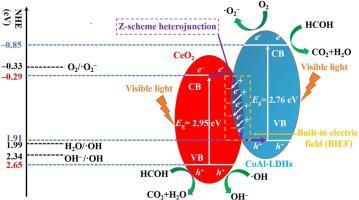Applied Catalysis B: Environment and Energy ( IF 22.1 ) Pub Date : 2020-06-27 , DOI: 10.1016/j.apcatb.2020.119266 Shengjie Xia , Guanhua Zhang , Yue Meng , Chao Yang , Zheming Ni , Jun Hu

|
While the removal of gaseous formaldehyde in breathing air via photocatalytic oxidation technology (POT) has shown great promise for pratical applications, the search of highly efficient and stable catalysts and mechanistic interpretations are highly desirable. We synthesized a core-shell structured composite of CeO2 and layered double hydroxides (CeO2@LDHs). The degradation of gaseous formaldehyde was realized with high efficiency under visible light irradiation using a home-built continuous flow reaction device at an industrial reaction scale. It was confirmed that the catalytic activity of LDHs after CeO2 complexation was significantly improved. Under optimum reaction conditions, a formaldehyde conversion of 86.9 % was achieved by CeO2@LDHs after 300 min equilibrium (3.73 μg g–1 h–1). Kinetic study showed that the flow rate of gaseous formaldehyde had the largest influence on the degradation rate of formaldehyde, followed by the relative humidity and the light intensity with a descending order. The rate equation and activation energy of photocatalytic degradation of formaldehyde were also obtained and discussed. The catalytically active radicals and the reaction intermediates were detected on CeO2@LDHs, shedding light on the intepretation of the reaction mechanism. Under the oxidation of hydroxyl and superoxide radicals and hot holes, gaseous formaldehyde was eventually degraded into carbon dioxide and water, as a result of the generation of formic acid, carbon hydrogen oxygen radicals (CHO) and
CO2– radicals. The present study demonstrates a systematic logical flow from design, preparation and mechanistic understanding of efficient LDHs-based photocatalyst for the degradataion of gaseous formaldehyde under practical conditions.
中文翻译:

核壳CeO 2 @LDHs光降解气态甲醛的动力学和机理分析
尽管通过光催化氧化技术(POT)去除呼吸空气中的气态甲醛已显示出在实际应用中的巨大希望,但非常需要寻找高效,稳定的催化剂和机理的解释。我们合成了CeO 2和层状双氢氧化物(CeO 2 @LDHs)的核-壳结构复合材料。使用自制的连续流反应装置,在工业反应规模下,在可见光照射下高效地实现了气态甲醛的降解。证实了CeO 2络合后LDHs的催化活性显着提高。在最佳反应条件下,CeO 2的甲醛转化率为86.9%@LDHs经过300分钟平衡(3.73μgg –1 h –1)。动力学研究表明,气态甲醛的流速对甲醛的降解速率影响最大,其次是相对湿度和光强度,其下降顺序依次为。得到并讨论了甲醛的光催化降解速率方程和活化能。在CeO 2 @LDHs上检测到了催化活性基团和反应中间体,从而阐明了反应机理。在羟基和超氧化物自由基和热孔的氧化作用下,气态甲醛最终由于生成甲酸,碳氢氧自由基而被降解为二氧化碳和水。CHO)和
CO 2-自由基。本研究证明了从设计,制备和对有效的基于LDHs的光催化剂在实际条件下降解气态的机理的理解的系统逻辑流程。


























 京公网安备 11010802027423号
京公网安备 11010802027423号